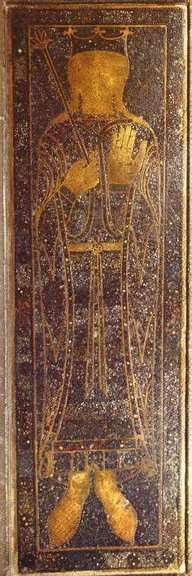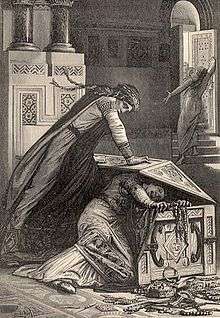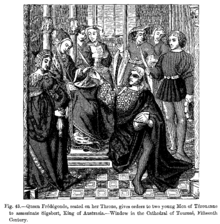Fredegund
Fredegund or Fredegunda (Latin: Fredegundis; French: Frédégonde; died 8 December 597) was the Queen consort of Chilperic I, the Merovingian Frankish king of Soissons.[1] She served as regent during the minority of her son Chlothar II from 584 until 597.

Fredegund has traditionally been given a very bad reputation, foremost by the accounts of Gregory of Tours, who depicts her as ruthlessly murderous and sadistically cruel, and she is known for the many cruel stories about her, particularly for her long going feud with queen Brunhilda of Austrasia.
Queen
Fredegund was born into a low-ranking family but gained power through her association with King Chilperic.[1] Originally a servant of Chilperic's first wife Audovera, Fredegund won Chilperic's affection and persuaded him to put Audovera in a convent and divorce her. Gregory of Tours remarks that Fredegund brought with her a handsome dowry, incurring the immediate affection of King Chilperic.[2]
Chilperic put Fredegund aside and married Galswintha. Galswintha died the same year, probably strangled by Fredegund[3](c. 568), who succeeded Galswintha as queen. Galswintha's sister, Brunhilda, however, began a feud which lasted more than 40 years.
Gregory of Tours suggests that the Queen had committed adultery. During a dinner with King Guntram, the recently widowed Fredegund rose to leave the table with the excuse that she is pregnant. The announcement surprised the King, as her son Clothar II was born only four months earlier. Gregory of Tours interprets this exchange as a result of Fredegund's unfaithfulness to her husband.[4]
In 580 AD, an epidemic of dysentery broke out in Gaul, afflicting Fredegund's husband King Chilperic and their two sons, Chlodobert and Dagobert. Believing the plague to be a result of her sins, Fredegund burned a number of tax records she feared were unjust and encouraged Chilperic to do the same. Her sons, however, did not survive the epidemic. Following their funerals, Fredegund made a large donation to churches and the poor to continue to atone for her sins.[5] Another of Fredegund's sons, Samson, was stricken with a serious illness while the family was under siege in Tournai. According to Gregory, Fredegund feared that she would catch the disease from Samson and cast him away from her, allowing him to die. The King was offended by her actions as the child had not yet been baptized. When Samson survived longer than expected, Fredegund relented and had him baptized according to the King's wishes.[4]
Conflict with Rigunth

Gregory of Tours records the bad relationship between Fredegund and her daughter Rigunth:
She was jealous of her own daughter, Rigunth, who continually declared that she should be mistress[6] in her place. Fredegund waited her opportunity and under the pretense of magnanimity took her to the treasure-room and showed her the King's jewels in a large chest. Feigning fatigue, she exclaimed "I am weary; put thou in thy hand, and take out what thou mayest find." The mother thereupon forced down the lid on her neck and would have killed her had not the servants finally rushed to her aid.
When Rigunth was sent off to her Visigothic fiancé in Spain Reccared, son of Liuvigild, her entourage was so laden with rich gifts that the Frankish nobles objected that the royal fisc had been depleted. Fredegund asserted that all the gifts had come out of property amassed by her husband's generosity. On the long journey, Rigunth's retainers repeatedly robbed and abandoned her, and by the time she reached Toulouse there was little left.[7] When Chilperic died in 584 AD, Desiderius of Aquitaine went to Toulouse to secure the remaining treasure.
The Neustrian ex-domesticus Leunardus travelled to the Cathedral of Paris, where the Queen was staying, to relay the news of Rigunth's capture. By Gregory's account, Fredegund was so enraged at Leunardus's message that she ordered his public humiliation in the center of the church. She had him beaten, chained, and jailed along with the cooks and bakers who accompanied him on the journey. She stopped short of killing him, however, due to his political status in the region.[2]
Regency

Upon the death of Chilperic I in 584, Fredegund became regent during the minority of her infant son Chlothar II.
Major attempts
Fredegund is said to have ordered the assassination of Sigebert I of Austrasia in 575 and also to have made attempts on the lives of Sigebert's son Childebert II, her brother-in-law Guntram, king of Burgundy, and Brunhild. After the mysterious assassination of Chilperic in 584 AD, Fredegund seized the Kings riches and took refuge in the Notre Dame de Paris cathedral.[2] Both she and her surviving son, Clothar II, were protected by Guntram until he died in 592. Newly widowed, Fredegund attempted to seduce the Neustrian official Eberulf but was ultimately rejected. Gregory of Tours later suspects her of orchestrating Eberulf's assassination.[2]
Persecution of Praetextatus
Additionally, Gregory of Tours suggests that the persecution of the Bishop Praetextatus was largely driven by Fredegund.[8] Following Praetextatus's return from exile, the Queen met him in church and threatened to have him exiled a second time. However, the Bishop was not concerned because he believed he would receive his reward in heaven, whereas Fredegund would be punished in hell.[5] In 586, Fredegund ordered the assassination of Praetextatus and had one of her agents stab him during Easter Mass.[4] The Queen later visited Praetextatus on his deathbed and offered the assistance of her physicians, which Gregory of Tours interprets as an excuse to witness the bishop's death. Praetextatus urged her to repent of her sins before finally succumbing to his wounds. Fredegund later conducted assassination plots against a number of political officials who condemned the assassination, including the Bishop of Bayeux and King Guntram.[2]
Death
Fredegund died of natural causes on 8 December 597 in Paris.[9] The tomb of Frédégonde is a mosaic figure of marble and copper, situated in the Saint Denis Basilica, having come from the abbey church of Saint-Germain-des-Prés.
Fredegund did not live to see it, but her son's execution of Brunhilda bore the mark of her conflict with Fredegund. Clothar II, then the king, ordered that she be tied by the arms and hair to the tail of a young, untamed horse, and dragged through the entire army. As soon as the king gave this order, it was carried out. The first time the man who was on the horse dug his spurs in, the horse kicked up his heels with such force that Brunhild's head flew off. Her body was dragged through the bushes and brambles, over hills and dales, so that it was torn to pieces, limb from limb.
Notes
- Denton, C.S. (2011). Absolute Power: The Real Lives of Europe’s Most Infamous Rulers. London: Arcturus Publishing. ISBN 978-1-84858-474-7.
- Dailey, E.T. (2015). Queens, Consorts, Concubines: Gregory of Tours and Women of the Merovingian Elite. Boston: BRILL. ISBN 978-90-04-29089-1.
- Gilman, D. C.; Peck, H. T.; Colby, F. M., eds. (1905). . New International Encyclopedia (1st ed.). New York: Dodd, Mead.
- Myrl Jackson-Laufer, Guida (1999). Women Rulers Throughout the Ages: An Illustrated Guide. Santa Barbara, CA: ABC-CLIO. ISBN 1-57607-091-3.
- Reimitz, Helmut (2015). History, Frankish Identity and the Framing of Western Ethnicity, 550-850. Cambridge: Cambridge University Press. ISBN 978-1-107-03233-0.
- Probably, as the translator O. M. Dalton notes, because Fredegund began life as a palace maid, while she was of royal blood, being a king's daughter.
- Gregory's report is repeated by Jo Ann McNamara and Suzanne Wemple, "The Power of Women through the Family in Medieval Europe: 500-1100", Feminist Studies 1.3/4 (Winter - Spring, 1973:126-141), p.130, with the observation "it required a strong hand and constant vigilance to retain wealth in those times".
- "Fredegund – FREE Fredegund information | Encyclopedia.com: Find Fredegund research". www.encyclopedia.com. Retrieved 2016-03-09.
- Waldherr, Kris (2008). Doomed Queens: Royal Women Who Met Bad Ends, From Cleopatra to Princess Di. New York: Crown/Archetype. ISBN 978-0-7679-2899-1.
References
- Gregory of Tours, History of the Franks, Book IX. Ch. 34, Translated by O. M. Dalton, Vol. II. pp. 405–406
- Alan Dundes, Cinderella: A Casebook, Ch. 1 The Cat Cinderella by Giambattista Basile (University of Wisconsin Press, 1982).
External links
| Wikimedia Commons has media related to Fredegund. |
. Encyclopædia Britannica (11th ed.). 1911.